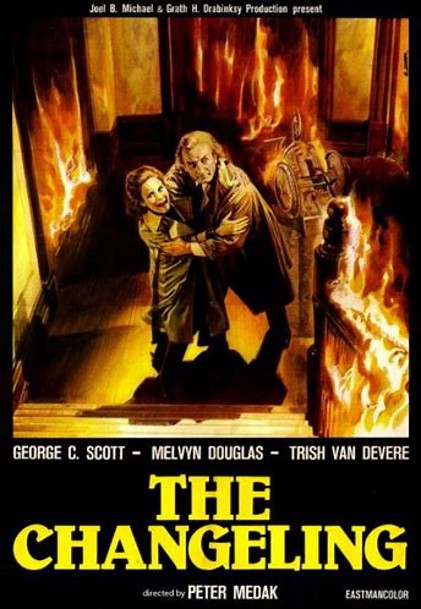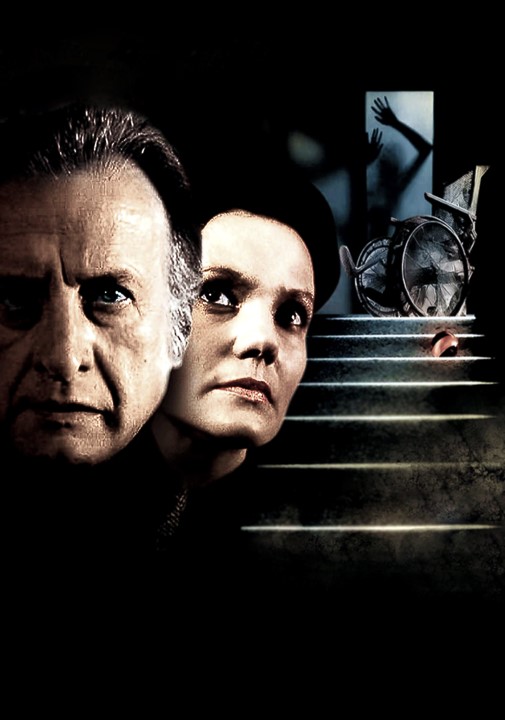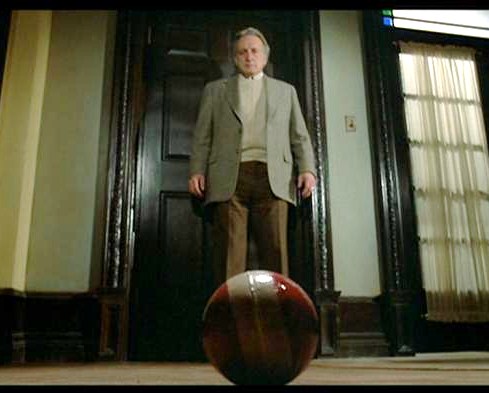The seventies were perhaps the most important decade for horror cinema. Crammed with ‘game changers,’ the horror movie templates that emerged from this time continue to play out in movies today. Which brings us to The Changeling, although technically considered an eighties movie due to its release date in 1980, The Changeling might be one of the last great genre movies to be shot in the seventies. Filmed from early December 1978 to late February 1979, The Changeling holds a curious place in horror history.

It was supposedly based on the true story of composer/playwright Russell Hunter’s experiences at The Henry Treat Rogers Mansion located in Denver, Colorado. He passed away in 1996. Hunter moved to the house from New York City to help his parents manage The Three Birches Lodge in Boulder. At $200 a month and off the books, Hunter believed he had himself a bargain, but about a week after he moved into the mansion, strange occurrences began taking place.
Every morning at 6 am, an “unbelievable crashing and banging” could be heard. Doors opened and closed by themselves. Walls vibrated violently. Faucets would turn on gushing water. Perhaps the reason for the great price nobody wanted to live there!
Not long after, Hunter and an architect friend came across a hidden staircase in the back of a closet that led to the third floor of the house. This is where Hunter found items belonging to a child who had lived in the house nearly a century before. Amongst the items, a journal, which detailed the life of a young disabled boy, who was kept in isolation, the boy, noted his favorite toy, a red rubber ball. A few nights later, a red rubber ball fell from the top of the staircase. Determining something supernatural was at work, Hunter decided to conduct a séance.
The movie, The Changeling, follows Hunter’s story more or less beat by beat with a few dramatic embellishments. George C Scott (the first actor to refuse an Oscar for his role as General George S. Patton in Patton) plays a renowned composer John Russell who loses his wife and daughter in a tragic accident at the start of the film. To make a fresh start, he moves to Seattle, where he has a new position as Professor of Music. Moving into a mysterious old mansion, John Russell’s experiences mirror that of Russell Hunters.
The Changeling is a movie that would sit perfectly alongside The Omen or The Amityville Horror on a double bill. A tightly directed, wonderfully acted, creepy mystery. Its pace seducing the audience into the terrors rather than delivering telegraphed jump scares every ten minutes.
If you have never watched it, now’s the moment to switch off the lights, draw the curtains, pour yourself a glass of your favorite tipple and allocate two hours of your time to it’s excellence. Often cited in greatest horror movie lists and with fans like Johnny Depp, Neve Campbell, and Martin Scorsese, The Changeling is worth your attention. Go on, go ahead, I will wait but BEWARE to read on might place us in areas that are considered Spoilerific!

Okay done? Then I will continue….
During the séance, Russell Hunter was told that the delicate young boy who had lived in the house and had been set to inherit his family’s fortune, died. His parents worried that their fortune might end up passing to a different part of the family decided to conceal the boy’s death by secretly burying his body and replacing him with a child from a local orphanage who bore a resemblance to their son.
The Changeling, which comes from European folklore, is usually a child that has been stolen by fairies and substituted for a fairy child. In this case, the Changeling Child was sent away to Europe just before the First World War only to return well educated, inheriting the family fortune and becoming a state senator.
Hunter also claims that during the séance, the spirit of the child spoke through him, revealing the location of his buried body. Getting permission to dig under a home on South Dahlia Street, Hunter uncovered the remains of a child and a gold medallion, which had the boy’s name inscribed upon it. Finding the body of the child did little to calm the paranormal activity, which intensified. Hunter claimed, “Glass doors blew up in my face and severed an artery in my wrist. The Inner walls over the head of my bed violently imploded.”
All this was enough to make him think twice about his current living situation. He moved from the home only to be followed by the strange activity, which continued sporadically until he returned to the house to watch it get demolished. Even then, Hunter claimed, “As the walls of the wing which had contained my bedroom collapsed, they suddenly flew outward and crushed to death the man operating the bulldozer.”
Fact-checking Russell Hunter is difficult; there are no records of Hunter ever living at this property, and tracing the history of the house doesn’t indicate that such a family ever resided there. Not only that, but timeline claims made by Hunter don’t seem to add up. Surely there would be some sort of documentation, proof of a child’s body being discovered under a home on South Dahlia Street or the death of a bulldozer driver at the Henry Treat Rogers House.
Scouring the Internet for facts on this case, I came across a forum where an unnamed actor who says he worked on one of Russell Hunter’s plays states, “Some of the marvelous cast meetings, rehearsals, and parties at Russell’s home during the production of his musical Little Boy Blue, Russell readily admitted that parts of the story of the Changeling were embellished, but the tale is a WONDERFUL one, and I remember snippets of others he gifted us with as well. He was a wonderful playwright and director, and I loved being part of that show at Loretta Heights.”
The Henry Treat Rogers mansion was located very close to Cheesman Park, which is one of the oldest and most desirable Neighborhoods in Colorado. It also happens to have been a cemetery previously. In 2010 irrigation workers came across bones while working in the park. Over the years, there have been many strange reports from the area.
To add to the strangeness of this story in an old Denver Magazine article from the 70’s Russell claims that a prominent Denver family, the Phipps, made many attempts to silence him, going as far at one point to put a hit out on him. Was this the family that allowed a Changeling into their ranks? We may never know. It is unusual that no copies of Hunter’s book are available online, and to find any information regarding the facts of the case requires a deep dive into The Denver Public Library’s historical archives.
Making the movie
Directed by Peter Medak (The Krays, Zorro The Gay Blade, Breaking Bad) The Changeling although set in Seattle, was mostly shot in Canada. Medak spoke to me about his own experiences on the set of the film.
Working as an assistant director in England on another project, Medak found himself at the same studio as Robert Wise (The Sound of Music, The Body Snatcher, West Side Story, and Star Trek The Motion Picture) who was shooting the genre classic The Haunting (1963). Medak spent every free second he had watching Wise work, and it was here that his love of supernatural cinema was cemented.
After the death of an elder Brother and tragically a wife who committed suicide, Medak felt vulnerable to the supernatural. So when he initially read the script for The Changeling, he was hooked. The screenplay by Dianna Maddox and William Grey was based on Russell Hunter’s accounts (they spent an additional six months researching the paranormal), and it terrified Medak. He wanted to be a part of this project. Replacing a friend of his, Donald Cammell, who left because of creative differences with the producers (Medak sent a telegram to get Cammell’s blessing before embarking on the shoot) Joel B Michaels and Garth H. Drabinsky.
Upon arriving in Canada with just under a month before principal photography was due to begin and visiting the location picked by the producers that would act as the house’s interior, Medak told Michaels and Drabinsky that it was entirely unsuitable for what he envisioned. They would need to build a set, at a substantial cost to the production which would allow him to achieve the feel for the movie he saw on the page. Initially, the producers refused to get the extra money that Medak needed, so he told them he wouldn’t be able to make the movie. Lying in his hotel room bed that night, at midnight, an envelope was slipped under his door. It seems the producers had enough faith in Medak to grant the additional costs, and the movie was on. Shot for six million dollars (a million of which went straight to George C. Scott), this was a relatively small budget for a feature of this magnitude at this time.

Medak told me how he was obsessed with creating a believable character out of the spirit. Cinematographer John Coquillon known for his work with Sam Peckinpah and for shooting The Witchfinder General, allows the camera to roam through the house representing the spirit and acting as a foreboding presence throughout.
When asked if anything strange happened on set, Medak tells me that a lot of odd occurrences took place. As part of his research for the movie, he observed a séance where the name of his deceased brother came up. One day after completing the filming, Medak returned to the set to retrieve a cardigan, which he had left there. The cardigan was hanging on a banister at the top of a staircase. After finding it and making his way down, he felt something pushing him down the stairs. Tumbling to the ground, he had been completely alone, and whether it was his imagination or not, this memory has stuck with him.
Perhaps the most iconic sequence of scenes in the film occurs when a red rubber ball falls from the ceiling prompting George C. Scott’s character to take it to a bridge and throw it into a river. When he returns to the house, the red rubber ball bounces down the staircase and lands at the feet of our hero. Achieving something like this today would be done using computers at the time though no such technology existed, so the sequence relied on good old fashioned timing. After a long day and many attempts to get the ball to perform as intended, Medak himself took the ball to the top of the staircase. He closed his eyes and let the ball slip out of his hand. It bounced down the staircase step by step and landed directly at Scott’s feet much to the amazement of the director, actor, and crew.

Similar to Gregory Peck in The Omen, George C. Scott brings a certain gravitas to the confused, obsessed John Russell. Married to Trish Van Devere, who played Clare Norman in the film. Scott won a Genie award for best foreign actor. Indeed the movie pretty much swept up at the very first Genie awards, including best foreign actress for Van Devere, best Cinematography for John Coquillon, and best motion picture.
Unfortunately and maybe due to the release of The Amityville Horror a year earlier, the distribution of The Changeling was not handled well. Consequently, the movie was criminally underseen on it’s initial showings. Over the years, it has built up a strong following with many loyal fans who credit it as being one of the scariest movies ever made. No surprise then that talk of a remake is always on the cards, Peter Medak tells me this is a subject that provokes just a twinge of jealousy. Still very active as a director for Television as well as film Medak would love a shot at directing a big budget scary feature. Just a few years ago, Medak was approached by Johnny Depp, who had purchased the rights to a book about a spiritualist entitled Inna Morata. Depp wanted the director of The Changeling behind his project alas though even with Depp’s star power, this movie languishes in development hell. “Scaring people is easy,” Medak tells me, “it’s all about suspense.”
Forty years after it’s release, The Changeling lives on. To this day, it’s influences can be seen in movies like The Ring, The Others, and Guillermo Del Toro’s Crimson Peak. The séance, spirit writing sequence is truly up there as one of the creepiest ever committed to film. Actress Helen Burns who plays the medium, almost steals the movie from the rest of the cast with just a brief amount of screen time. The fiery climax of the film, once seen, is never forgotten. The movie even has an Egyptian counterpart that Russell Hunter is credited as a writer on. The Movie entitled Aad Liyantaquim translates as He who returned for Vengeance; it was released just eight years after The Changeling in 1988 and is a testament to the original’s worldwide appeal.
One thing is for sure, the story of The Changeling continues to endure and find new audiences as time goes on. That my friends is the mark of a very special movie indeed.